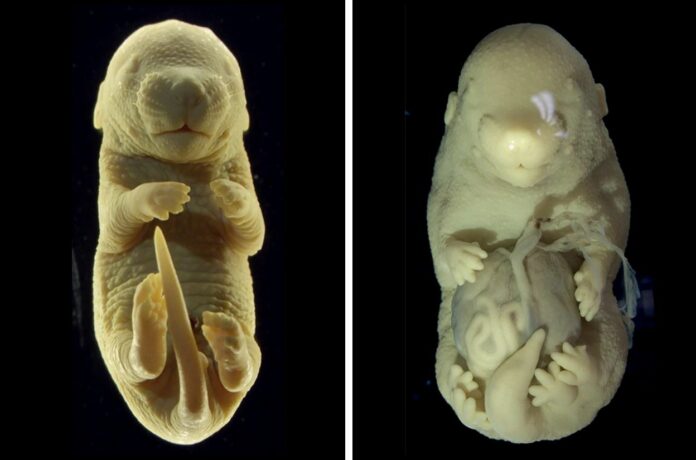Scientists have created a 6-legged mouse embryo with an extra pair of hindlimbs at the expense of their external genitalia. But far from creating a monster, this rudimentary rodent provides important insights into the early stages of animal development and uncovers secrets about our own evolution.
We all start our lives as a microscopic, limbless bean that gradually grows arms and legs as a result of a complex network of chemical instructions. These instructions tell certain genes to switch on and off depending on where they are located in the body. And these instructions become more and more specific as we grow.
For example, at the beginning, a cell might just know that it’s located somewhere near the top of the growing group of cells. But later down the line, this cell learns that it is located on the left side of the head and is destined to become one of the hair-like cells in our inner ear.
Anastasiia Lozovska et al/Nat. Comms
One important group of chemical instructions is the TGF-β family of growth factors. To respond to these growth factors, cells produce a complementary family of receptors. One key receptor, known as Tgfβ receptor 1, or Tgfbr1, is known to play an important role in controlling the formation of hindlimbs and external genitalia.
To investigate the role of this chemical crosstalk in embryonic development, a team of researchers at the Gulbenkian Science Institute in Oeiras, Portugal, inactivated the gene encoding the Tgfbr1 receptor halfway through the development of mouse embryos. Their results were published in the journal Nature Communications.
Originally, the team, led by Moisés Mallo, was interested in how this change in gene expression might impact the development of the spinal cord. However, what they found was totally unexpected: the development of two additional hindlimbs in the place of external genitalia.
Probing further, the team found that Tgfbr1 dictates whether our limb buds develop into hindlimbs or genitals by altering the way that DNA folds inside the cells in these limb structures. So by deactivating Tgfbr1, the team inadvertently changed the expression of other genes inside the mouse embryo’s cells, resulting in its extra pair of legs.
“Our work uncovers a remarkable tissue plasticity with potential implications in the evolution of the hindlimb/genital area of [four-legged animals],” the authors write.
The researchers hope that by improving our understanding of these early developmental pathways we can gain important insights into the underlying mechanisms of various developmental diseases.
While these studies were performed in mice, our early developmental pathways are fairly well conserved across different mammals because any small changes in their function have drastic (and often detrimental) effects on the development of the growing organism. Therefore, we can translate a lot of what we know from mouse embryos into human development.
Is there a health problem that’s worrying you? Do you have a question about embryonic development? Let us know via [email protected]. We can ask experts for advice, and your story could be featured on Newsweek.
Uncommon Knowledge
Newsweek is committed to challenging conventional wisdom and finding connections in the search for common ground.
Newsweek is committed to challenging conventional wisdom and finding connections in the search for common ground.


